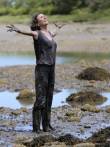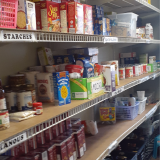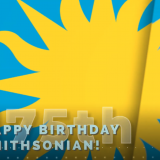Women Mind the Water Podcast Series: Dale Andree, Florida
Story Narrative:
Submitted as part of the Women Mind the Water (WMW) digital stories project produced by Pam Ferris-Olson, in conjunction with Stories from Main Street and the traveling exhibition "Water/Ways." This story is one in a series created for a podcast in 2020-21, featuring regional artists whose inspiration blends conversation, activism, science, and water. Find earlier stories from the WMW initiative by searching for "Women Mind the Water" on this website.
Dale Andree, dance artist/educator, aims to raise environmental awareness and inspire action through dance. She has created performances and films on sites as diverse as mudflats in Maine and mangrove forests in Florida. Dale is the founder and director of National Water Dance, a project that mobilizes dancers from across the United States including Puerto Rico to simultaneously share their expression of issues related to water quality and climate change.
Pam Ferris-Olson (00:00): The Women Mind the Water Podcast, engages artists in conversation about their work and explores their connection with the ocean. Through these stories, Women Mind the Water hopes to inspire and encourage action to protect the ocean and her creatures. Today, I am speaking with Dale Andree. Dale is a dance artist and educator whose work aims to raise environmental awareness and inspire action. She has created performances and films on sites as diverse as mudflats in Maine and mangrove forest in Florida. Dale also is the founder and director of National Water Dance, a project that mobilizes dancers from across US, including Puerto Rico to simultaneously share their expression of issues related to water quality and climate change. Welcome Dale, let me start by asking about your journey as a dancer. Did you always envision yourself as a dancer?
Dale Andree (01:05): I always danced. I danced from a very early age, but not seriously training. I didn't actually start to seriously train until I was in college, which is actually quite late. I had lots of experiences in creating performances. I think that was the thing that I was always doing from an early age, was wanting to create performances, but the actual training as a dancer began in college.
Pam Ferris-Olson (01:39): So how did you arrive at the decision that you wanted to be a catalyst for environmental change and particularly issues related to water? Was there a watershed moment where you felt that this was something you just needed to do?
Dale Andree (01:54): I've always been very grounded in nature. It's always been my source of, I think spiritual centering. And as a dancer, I've always enjoyed site-specific work, which means work outside the theater, creating work in spaces, whether urban or natural. And I became interested in the National Water Dance is based on, which is a movement choir. And there's a little history to that. I won't go into all of that, but it was created by [inaudible 00:02:30] in the last century. And Mary Lee Hardenbergh is someone who's made movement choirs all over the world. And then I was inspired by her work that she did on the Mississippi river. And it was all along the river with just communities of dancers of all abilities and movers along the river, coming together with similar movement phrases and creating community around this incredible water system and through movement.
And I wanted to do something like that in Florida. I wanted to connect our state. Actually to begin with, I wanted to connect us through all of our arts institutions, because we have so many in the state of Florida from elementary school, through the university system. And to connect us as dancers through our waterways, which of course are primary in Florida. And that was in 2011. And then from there, because it was so satisfying and successful, I decided to make it national. And it took me three years to actually get that going on a national basis.
Pam Ferris-Olson (03:41): I believe your preferred form of dance expression is improvisational. Does improvisational movement provide a dancer with a more authentic way to express themselves? And how can their truth be used to convey an environmental message to an audience?
Dale Andree (03:59): I feel like that deep listening into our bodies takes us easily into the deep listening of nature and in creating work in natural settings, it really requires that place of quieting the mind and the body and receiving the energy from the space. And that's something that really truly exists and you can feel it through your feet. You feel like the texture of the ground, you feel whether it's mud or if it's uneven or sand, or if you're in water. And then of course, all of the elements that are around you and that connection and ability to respond through improvisation, I feel has the deepest possible expression of the dancer in the environment. I think the idea of bringing art into a space and really becoming a part of it can just highlight for people, sometimes spaces that maybe they see all of the time. But all of a sudden they see it in relationship to something that doesn't belong there to moving bodies and seeing how those bodies move through that space can just really and juxtaposition sort of will highlight the image, just make it even more powerful.
I think for example, Christo, the visual artist did a piece here in Miami called Surrounded Islands and he surrounded these islands that were between mainland Miami and Miami beach. And he surrounded them with this pink material that was porous and was safe for the fish and everything. But it was this big border around these islands and there was lots of controversy over it at the time. I don't think I had a particular sense of what I thought of it, but going across the causeway and seeing that pink material around those islands, particularly at different times of day, the way you would catch the light or the sunset, I can't go across the cause way these many years later when there's no longer material there and not stop and look at those islands. And just see them in a heightened visual experience. And I think this whole experience too, because of that. So that's what we hope to do is to enter into the natural surroundings and bring people's experience into it on a deeper level.
Pam Ferris-Olson (06:38): What are the basic elements that need to come together? And how long does it take to create a dance?
Dale Andree (06:44): That's a huge question. With National Water Dance, I mean, there are people that will create an improvisational dance and because it's improvisational, you do rehearse improvisation, but you can also do it spontaneously. So the dance could be created in the moment. Other dances, like the one I'm working on right now, take a great deal of time of settling into the location we're in, getting to know it, being able... We're working in the mangroves right now. So knowing the mangroves and respecting them and not wanting to interfere with any of the natural systems that are there, learning how to walk on the roots and not break anything and becoming part of it in a way that is like anyone who'd spent a lot of time in a natural setting, you get to know it on so many levels.
And then from that finding movement and taking those movement ideas and shaping them into a choreography that has formed that will take the audiences' eye from the beginning to the end, hopefully. Many times there are other elements that are involved. Are there costumes? Are there projections? All those added things, but the basic choreography comes from the experience of the dancers in the moment with one another, with the natural surroundings and then structuring it in a way that we feel presents our experience to the audience effectively.
Pam Ferris-Olson (08:20): I'd like to hear this story behind a particular dance you've created, or maybe the one you're creating now and why you're discussing it. Please describe the dance for those who are listening to an audio only version of the podcast.
Dale Andree (08:35): I've always wanted to do an audio only dance performance, but this won't be quite that. Well, we're working on this piece in the mangroves that's a part of a larger project that involves women in very different communities in Miami and what their response to climate changes on a generational basis. Bringing the community together with a sense that as we move forward in addressing climate change, we can only do it together. Can't be a one person's problem or one community problem. And so the mangroves really represent that in the way that their root systems have to work together. They're intertwined and they hold the coastline. So we have created movement inside the mangroves where the mangroves have supported us, and then we've taken that movement and become the root system and the trunks of the mangroves for each dancer to do the movement that they did on the mangroves, but now using the dancers as support in counterbalance and leaning.
So we transfer that forest into our own bodies. We also have really paid attention to the ongoing cycle of life, which we all experience and nature. We see it all the time. And the mangrove forest is so clear because of the continual new growth that is very apparent right underneath the mature trees. And then of course, the dying trees and all being part of this one continual cycle of life. And that sense of cyclical action has drawn us into creating circular designs. That's what begins the piece. Walking in individual circles that overlap, come together, the dancers interact for a moment, but then shoot off into their individual circles. But the circles are always intertwining, even as each individual has their own journey.
So that's the beginning, the formation of the piece that then moves into the final section. We also have worked with the sense of flow of water flow and how that affects our bodies as we watch the different textures of the ripples or this sudden official movement. So there's an instant of sudden movement, and there's a whole section that reflects that action. And it ends with the place where all the dancers come together, I guess finally, completely being human beings. Taking the gestures that have come from the women in the community that we've interacted with and transforming those gestures into the larger dance phrase.
Pam Ferris-Olson (11:27): Thank you. How has dance and specifically the National Water Dance project, an expression of you and your view of the world?
Dale Andree (11:36): Well, as a dancer, I express myself through movement. So being able to catalyze people to move and to move in community. Community is, and has always been very important to me. How we're influenced by each other and the power of one becoming the power of many. And watching that just magnify across the country has been very exciting. And as it's grown with, it's a bi-annual event. So the next one is 2022. And with each one there's added dimensions. In the beginning, it was really allowing each person to identify the water issues in their area. And that's always at the base of this, but gradually as we've gone on, we've taken on more directly climate change, which affects all of us. And the fact that environmental activism is social activism. So how we interact as human beings in nature with the most fundamental part that we all need at water, just pools all of those aspects together for me.
Pam Ferris-Olson (12:51): How would you like others to react to your dance?
Dale Andree (12:55): Reactions are so individual, and I don't know that any artist really creates anything with an idea of how someone's going to react to it. But my hope is as people look at what we do, that they're intrigued, they're curious, and ultimately because this is a mission for us that it will bring a heightened awareness of the beauty and the nature that we live in. That it is who we are. That it's not something apart from us that we can just look at and enjoy. But in fact, it is us and bringing that sense that our community is our natural surroundings and that as people watch the dance, they see that integration and hopefully get pulled into it as well.
Pam Ferris-Olson (13:49): So what's next for National Water Dance and for Dale?
Dale Andree (13:54): Well, National Water Dance is kind of we're really making it an ongoing presence as much as we can through social media and engagement with people. We've been doing Black Nature Conversations starting last fall, which is an Instagram live conversation between black dance artists who have been inspired by work in the environment. We're working on a world water day campaign that was inspired by the University of Southern Mississippi. That's a thank you to waters that generates movement into dance. So it was a thank you note that becomes a dance, and we're continually looking for those connections and reaching out to people across the country to participate with us. So anyone who's listening to this, please look at nationalwaterdance.org, get in touch with us.
We're also hoping for 2022 to have a film festival that the premise will be dancing in endangered, ecological landscapes. Those that are already facing and seeing climate change from urban climate gentrification to natural sea level rise and flooding, and wherever else. Fires that come from the changes in our environment. So it's an ongoing process and ever growing we hope.
Pam Ferris-Olson (15:16): I have been speaking with Dale Andree for the Women Mind the Water Podcast series. This series can be viewed on womenmindthewater.com. An audio only version of this podcast is available on the Women Mind the Water website and on iTunes. All rights for the Women Mind the Water name and logo belong to Pam Ferris-Olson. This is Pam Ferris-Olson. Thank you for listening.
Asset ID: 2021.02.09
Themes: Water, waterways, conservation, artists, dance, dancers, humanities, mangroves, climate change, community
Date recorded: March 28, 2021
Length of recording: 15:42 m
Related traveling exhibition: Water/Ways
Sponsor or affiliated organization: Women Mind the Water
More information: https://womenmindthewater.com/
Media Files:
-
Hear Dale's story (includes open captions).
-
Audio version of Dale's story.
-
Dale Andree, courtesy of the artist




